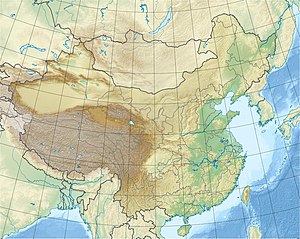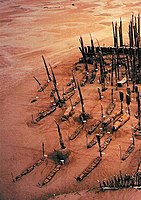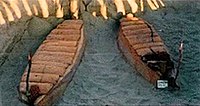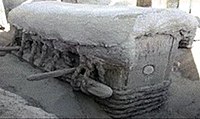404:
444:
708:"Biological anthropological research indicates that the physical characteristics of those buried at Gumugou cemetery along the Kongque River near Lop Nur in Xinjiang are very similar to those of the Andronovo culture and Afanasievo culture people from Siberia in Southern Russia. This suggests that all of these individuals belong to the Caucasian physical type.¹² Additionally, excavations in 2002 by Xinjiang archaeologists at the site of Xiaohe cemetery, first discovered by the Swedish archaeologist Folke Bergman,¹³ uncovered mummies and wooden human effigies that clearly have Europoid features . According to the preliminary excavation report, the cultural features and chronology of this site are said to be quite similar to those of Gumugou.¹⁴ Other sites in Xinjiang also contain both individuals with Caucasian features and ones with Mongolian features. For example, this pattern occurs at the Yanbulark cemetery in Xinjiang, but individuals with Mongoloid features are clearly dominant.¹³ The above evidence is enough to show that, starting around 2,000 B.C., some so-called primitive Caucasians expanded eastward to the Xinjiang area as far as the area around Hami and Lop Nur. By the end of the second millennium, another group of people from Central Asia started to move over the Pamirs and gradually dispersed in southern Xinjiang. These western groups mixed with local Mongoloids¹⁶ resulting in an amalgamation of culture and race in middle Xinjiang east to the Tianshan. "
416:
548:
found "the Early Bronze Age
Dzungarian individuals exhibit a predominantly Afanasievo ancestry with an additional local contribution, and the Early–Middle Bronze Age Tarim individuals contain only a local ancestry. The Tarim individuals from the site of Xiaohe further exhibit strong evidence of milk proteins in their dental calculus, indicating a reliance on dairy pastoralism at the site since its founding. The results do not support previous hypotheses for the origin of the Tarim mummies, who were argued to be Proto-Tocharian-speaking pastoralists descended from the Afanasievo or to have originated among the Bactria–Margiana Archaeological Complex or Inner Asian Mountain Corridor cultures. Instead, although Tocharian may have been plausibly introduced to the Dzungarian Basin by Afanasievo migrants during the Early Bronze Age, the earliest Tarim Basin cultures appear to have arisen from a genetically isolated local population that adopted neighbouring pastoralist and agriculturalist practices, which allowed them to settle and thrive along the shifting riverine oases of the Taklamakan Desert."
280:
392:
552:
352:
380:
29:
125:
54:
300:. The tomb complex appeared as a small oval mound, and the top of the burial mound was covered with a forest of erect wooden posts whose tops had been splintered by strong winds. Oar-shaped wooden monuments and wooden human figures were found at the site. The coffins were assembled over the bodies which had become mummified. Bergman excavated 12 burials and recovered approximately 200 artifacts that were transported back to Stockholm. Bergman noted the surprising resemblance in the clothing, especially the fringed loin-cloths, to
368:
340:
94:
61:
329:
posts, while the female burials were marked with the phallic posts. Bows and arrows were found with the male burials. The posts and coffins may be painted red. Each coffin is made of two massive pieces of plank assembled over the body, resembling an overturned boat, and then covered with cowhides. A few special tombs containing females have an extra rectangular coffin on top covered with layers of mud. Small masks of human faces and wooden human figures may accompany the burials. Twigs and branches of
87:
428:
403:
320:, began at the site. A total of 167 tombs have been uncovered since the end of 2002, and excavations have revealed hundreds of smaller tombs built in layers. In 2006, a coffin wrapped with ox hide in the shape of a boat was found. It contained a remarkably intact mummy of a young woman, which came to be called the Beauty of Xiaohe (or Beauty of Loulan).
443:
328:
Each tomb is marked by a vertical poplar post near the upper end of the coffin. A skull or horn of an ox may be suspended from the post. The ends of the posts can be either torpedo-shaped or oar-shaped, representing the phallus and vulva respectively. The male burials were marked with the oar-shaped
1151:
Zhang, Fan; Ning, Chao; Scott, Ashley; Fu, Qiaomei; Bjørn, Rasmus; Li, Wenying; Wei, Dong; Wang, Wenjun; Fan, Linyuan; Abuduresule, Idilisi; Hu, Xingjun; Ruan, Qiurong; Niyazi, Alipujiang; Dong, Guanghui; Cao, Peng; Liu, Feng; Dai, Qingyan; Feng, Xiaotian; Yang, Ruowei; Tang, Zihua; Ma, Pengcheng;
547:
Fan Zhang et al. (2021) examined genomic data from five individuals dating to around 3000–2800 BC from the
Dzungarian Basin and thirteen individuals dating to around 2100–1700 BC from the Tarim Basin, representing the earliest yet discovered human remains from North and South Xinjiang. Researchers
254:
The cemetery resembles an oblong sand dune. From it the remains of more than 30 people, the earliest of whom lived around 4,000 years ago, have been excavated. The bodies, which have been buried in air-tight ox-hide bags, are so well-preserved that they have often been referred to as the
270:
The Xiaohe cemetery complex contains the largest number of mummies found at any single site in the world to date. The bodies are likely to have been transported significant distances for burial at Xiaohe, as no contemporaneous settlement is known to have existed near the tomb complex.
415:
391:
262:
The Xiaohe remains have attracted considerable attention, particularly because of their "Caucasoid" appearance. Analysis of the Xiaohe population's genetic makeup has revealed that they represented a genetic bottleneck, essentially derived from
675:
The Xiaohe culture is known from two key sites, the Xiaohe
Cemetery itself (Xiaohe Archaeological Team, 2004; Xiaohe Archaeological Team, 2005; Xiaohe Archaeological Team, 2007) and the cemetery of Gumuguo (Han, 1986; Wang, 2014) in the same
1219:. Reports from the Scientific Expedition to the Northwestern Provinces of China under the Leadership of Dr. Sven Hedin / Scientific Expedition to the North-Western Provinces of China. Vol. Publication 7. Stockholm: Thule.
690:: "These mummies, especially the prehistoric Bronze Age 'Caucasoid' mummies, such as the 'Beauty of Loulan', have attracted extensive interest among scientists regarding who were these people and where did they come from."
465:
Genetic analyses of the mummies showed that the maternal lineages of the Xiaohe people originated from both East Asia and West
Eurasia, whereas all of the paternal lineages had links to modern populations of West Eurasia.
351:
1152:
Li, Chunxiang; Gao, Shizhu; Xu, Yang; Wu, Sihao; Wen, Shaoqing; Zhu, Hong; Zhou, Hui; Robbeets, Martine; Kumar, Vikas; Krause, Johannes; Warinner, Christina; Jeong, Choongwon; Cui, Yinqiu (27 October 2021).
1369:
279:
785:"Questions of Ancient Human Settlements in Xinjiang and the Early Silk Road Trade, with an Overview of the Silk Road Research Institutions and Scholars in Beijing, Gansu, and Xinjiang"
551:
945:
Chunxiang Li, Hongjie Li, Yinqiu Cui, Chengzhi Xie, Dawei Cai, Wenying Li, Victor H Mair, Zhi Xu, Quanchao Zhang, Idelis
Abuduresule, Li Jin, Hong Zhu and Hui Zhou (2010).
883:
1061:
996:
1294:
1236:
Bergman, Folke (1945). "Travels and
Archaeological Field-work in Mongolia and Sinkiang: a Diary of the Years 1927–1934". In Hedin, Sven; Bergman, Folke (eds.).
379:
469:
Mitochondrial DNA analysis, which reveals the maternal ancestry, showed that maternal lineages carried by the Xiaohe people include West
Eurasian haplogroups
1076:"中国北方古代人群Y染色体遗传多样性研究--《吉林大学》2012年博士论文 (Zhōngguó běifāng gǔdài rénqún Y rǎnsètǐ yíchuán duōyàng xìng yánjiū--"jílín dàxué"2012 nián bóshì lùnwén)"
53:
1012:"Analysis of ancient human mitochondrial DNA from the Xiaohe cemetery: insights into prehistoric population movements in the Tarim Basin, China"
1359:
1214:
1277:
1315:
367:
339:
317:
1100:
Li, C.; Li, H.; Cui, Y.; Xie, C.; Cai, D.; Li, W.; Mair, V. H.; Xu, Z.; Zhang, Q.; Abuduresule, I.; Jin, L.; Zhu, H.; Zhou, H. (2010).
86:
569:
244:. It contains about 330 tombs, about 160 of which were looted by grave robbers before archaeological research could be carried out.
1010:
Chunxiang Li, Chao Ning, Erika
Hagelberg, Hongjie Li, Yongbin Zhao, Wenying Li, Idelisi Abuduresule, Hong Zhu and Hui Zhou (2015).
152:
898:
292:
A local hunter named Ördek found the site around 1910. Later, in 1934, with Ördek's help, Swedish explorer and archeologist
580:
525:. On the other hand, nearly all (11 out of 12 - or around 92%) of surveyed paternal lines are of West Eurasian haplogroup
1354:
427:
1242:. General reports, travels and field-work. Vol. Reports: Publication 26. Stockholm: Statens Etnografiska Museum.
1364:
28:
397:
Burial XHM66 from Xiaohe cemetery, with boat-shaped coffin and mummified remains dressed in woollen garments.
537:
526:
264:
1374:
924:
638:
556:
1237:
1055:
990:
947:"Evidence that a West-East admixed population lived in the Tarim Basin as early as the early Bronze Age"
454:
Between 2009 and 2015, the remains of 92 individuals found at the Xiaohe Tomb complex were analyzed for
1165:
731:
522:
518:
514:
510:
506:
502:
498:
494:
490:
486:
482:
478:
474:
470:
805:
615:
1228:
830:
842:
666:
590:
536:
According to a comment posted on 18 July 2014 by Hui Zhou, one of study's co-authors, the Xiaohe
358:
1273:
1256:
1220:
1191:
1133:
1043:
978:
765:
747:
658:
540:
lineages belonged to a specifically
European branch rather than the more common Central Asian
38:
1102:"The origin of Xiaohe Bronze Age mummies, 18 July 2014, posted by Hui Zhou, Jilin University"
865:
701:
1181:
1173:
1123:
1113:
1075:
1033:
1023:
968:
958:
755:
739:
650:
248:
203:
530:
448:
330:
784:
533:. The geographic location of this admixing is unknown, although south Siberia is likely.
1169:
735:
296:
located the site which he named Xiaohe, "little river", after a nearby tributary of the
1186:
1153:
1128:
1101:
1038:
1011:
973:
946:
760:
719:
574:
541:
1348:
1247:
Mair, V. H. (2006). "The rediscovery and complete excavation of Ördek's
Necropolis".
670:
595:
585:
293:
256:
297:
34:
1177:
743:
1028:
654:
301:
229:
1330:
1317:
1260:
751:
662:
639:"A new hypothesis for early Bronze Age cultural diversity in Xinjiang, China"
167:
154:
1224:
1195:
1137:
1118:
1047:
982:
963:
769:
237:
140:
1295:"DNA Reveals These Red-Haired Chinese Mummies Come From Europe And Asia"
283:
The site of the cemetery; the vertical posts indicate the tomb locations
251:
slightly to the north is also considered as part of the Xiaohe culture.
1216:
Archaeological Researches in Sinkiang. Especially in the Lop-Nor Region
305:
233:
1270:
Ursprünge der Seidenstraße. Sensationelle Neufunde aus Xinjiang, China
211:
550:
459:
455:
442:
241:
130:
555:
The mummies of the Xiaohe Cemetery were essentially derived from
509:; haplogroups of most likely Central Asian or East Asian origin
884:"The rediscovery and complete excavation of Ördek's Necropolis"
1239:
History of an Expedition in Asia 1927–1935. Part IV: 1933–1935
447:
Reconstruction of a female individual from Xiaohe Cemetery.
1154:"The genomic origins of the Bronze Age Tarim Basin mummies"
720:"The genomic origins of the Bronze Age Tarim Basin mummies"
316:
In October 2003, an excavation project, organized by the
1370:
Major National Historical and Cultural Sites in Xinjiang
1272:. Reiss-Engelhorn-Museen, Mannheim. Stuttgart: Theiss.
637:
Betts, A.; Jia, P.; Abuduresule, I. (1 March 2019).
616:"Burial Site from the Bronze Age, Lop Nur, Xinjiang"
529:, and one is of exceptionally rare basal paragroup
188:
183:
146:
136:
118:
318:Xinjiang Cultural Relics and Archaeology Institute
843:"Silk Road Documentary Unearths Latest Findings"
517:; as well as typically South Asian haplogroups
706:. Stockholm: Fälth & Hässler. p. 13.
8:
1268:Wieczorek, Alfried; Lind, Christoph (2007).
1060:: CS1 maint: multiple names: authors list (
995:: CS1 maint: multiple names: authors list (
21:
940:
938:
221:
687:
20:
1185:
1127:
1117:
1037:
1027:
972:
962:
759:
925:"A Host of Mummies, a Forest of Secrets"
385:Xiaohe cemetery (double-layered coffin).
278:
224:'little river cemetery'), also known as
73:Location of Xiaohe Tomb complex in China
864:Samuel Hughes (January–February 2011).
607:
335:
308:, but dismissed any direct connection.
1053:
988:
831:Archaeological Researches in Sinkiang.
361:(female mummy with European features).
41:, and the location of Xiaohe Cemetery.
421:Wooden sculpture from Xiaohe cemetery
409:The Beauty of Xiaohe, Xinjiang Museum
7:
16:Cemetery in Ruoqiang County, China
14:
570:List of Bronze Age sites in China
1249:Journal of Indo-European Studies
891:Journal of Indo-European Studies
426:
414:
402:
390:
378:
366:
350:
338:
123:
92:
85:
59:
52:
27:
923:Nicholas Wade (15 March 2010).
643:Archaeological Research in Asia
373:Xiaohe cemetery (boat coffins).
345:Xiaohe cemetery (fourth layer).
288:Discovery and early excavations
897:(3/4): 273–318. Archived from
216:
93:
60:
1:
1360:Archaeological sites in China
333:were placed beside the body.
718:Zhang, Fan (November 2021).
232:site located in the west of
76:Show map of Continental Asia
871:. The Pennsylvania Gazette.
1391:
1178:10.1038/s41586-021-04052-7
744:10.1038/s41586-021-04052-7
1029:10.1186/s12863-015-0237-5
811:. 北京青年报. 15 November 2019
655:10.1016/j.ara.2018.04.001
497:; East Asian haplogroups
207:
46:
26:
324:Description of the tombs
1213:Bergman, Folke (1939).
265:Ancient North Eurasians
1119:10.1186/1741-7007-8-15
964:10.1186/1741-7007-8-15
700:Shuicheng, Li (2003).
560:
557:Ancient North Eurasian
451:
284:
554:
446:
357:Xiaohe cemetery, the
282:
792:Sino-Platonic Papers
783:Jan Romgard (2008).
1355:Bronze Age in China
1331:40.3364°N 88.6725°E
1327: /
1170:2021Natur.599..256Z
882:V. H. Mair (2006).
736:2021Natur.599..256Z
168:40.3364°N 88.6725°E
164: /
23:
22:Xiaohe Tomb Complex
904:on 2 November 2013
618:. www.china.org.cn
561:
452:
359:Princess of Xiaohe
285:
226:Ördek's Necropolis
1279:978-3-8062-2160-2
1164:(7884): 256–261.
730:(7884): 256–261.
312:Later excavations
196:
195:
109:Show map of China
39:Taklamakan Desert
1382:
1365:Bronze Age sites
1342:
1341:
1339:
1338:
1337:
1336:40.3364; 88.6725
1332:
1328:
1325:
1324:
1323:
1320:
1309:
1307:
1305:
1283:
1264:
1255:(3–4): 273–318.
1243:
1232:
1231:on 20 July 2011.
1227:. Archived from
1200:
1199:
1189:
1148:
1142:
1141:
1131:
1121:
1097:
1091:
1090:
1088:
1086:
1080:cdmd.cnki.com.cn
1072:
1066:
1065:
1059:
1051:
1041:
1031:
1007:
1001:
1000:
994:
986:
976:
966:
942:
933:
932:
920:
914:
913:
911:
909:
903:
888:
879:
873:
872:
870:
861:
855:
854:
852:
850:
839:
833:
827:
821:
820:
818:
816:
810:
802:
796:
795:
789:
780:
774:
773:
763:
715:
709:
707:
697:
691:
685:
679:
678:
634:
628:
627:
625:
623:
612:
430:
418:
406:
394:
382:
370:
354:
342:
249:Gumugou cemetery
223:
218:
209:
179:
178:
176:
175:
174:
173:40.3364; 88.6725
169:
165:
162:
161:
160:
157:
129:
127:
126:
110:
96:
95:
89:
77:
63:
62:
56:
31:
24:
1390:
1389:
1385:
1384:
1383:
1381:
1380:
1379:
1345:
1344:
1335:
1333:
1329:
1326:
1321:
1318:
1316:
1314:
1313:
1303:
1301:
1293:
1290:
1280:
1267:
1246:
1235:
1212:
1209:
1207:Further reading
1204:
1203:
1150:
1149:
1145:
1099:
1098:
1094:
1084:
1082:
1074:
1073:
1069:
1052:
1009:
1008:
1004:
987:
944:
943:
936:
922:
921:
917:
907:
905:
901:
886:
881:
880:
876:
868:
863:
862:
858:
848:
846:
841:
840:
836:
829:Folke Bergman:
828:
824:
814:
812:
808:
804:
803:
799:
787:
782:
781:
777:
717:
716:
712:
699:
698:
694:
686:
682:
636:
635:
631:
621:
619:
614:
613:
609:
604:
566:
449:Xinjiang Museum
441:
439:Genetic studies
434:
431:
422:
419:
410:
407:
398:
395:
386:
383:
374:
371:
362:
355:
346:
343:
326:
314:
304:grave finds in
290:
277:
200:Xiaohe Cemetery
172:
170:
166:
163:
158:
155:
153:
151:
150:
124:
122:
114:
113:
112:
111:
108:
107:
104:
103:
102:
101:
97:
80:
79:
78:
75:
74:
71:
70:
69:
68:
64:
42:
17:
12:
11:
5:
1388:
1386:
1378:
1377:
1372:
1367:
1362:
1357:
1347:
1346:
1311:
1310:
1289:
1288:External links
1286:
1285:
1284:
1278:
1265:
1244:
1233:
1208:
1205:
1202:
1201:
1143:
1092:
1067:
1002:
934:
929:New York Times
915:
874:
856:
845:. china.org.cn
834:
822:
797:
775:
710:
692:
688:Li et al. 2010
680:
629:
606:
605:
603:
600:
599:
598:
593:
588:
583:
578:
575:Loulan Kingdom
572:
565:
562:
440:
437:
436:
435:
432:
425:
423:
420:
413:
411:
408:
401:
399:
396:
389:
387:
384:
377:
375:
372:
365:
363:
356:
349:
347:
344:
337:
325:
322:
313:
310:
289:
286:
276:
273:
194:
193:
190:
186:
185:
181:
180:
148:
144:
143:
138:
134:
133:
120:
116:
115:
106:Xiaohe (China)
105:
99:
98:
91:
90:
84:
83:
82:
81:
72:
66:
65:
58:
57:
51:
50:
49:
48:
47:
44:
43:
32:
15:
13:
10:
9:
6:
4:
3:
2:
1387:
1376:
1375:Tarim mummies
1373:
1371:
1368:
1366:
1363:
1361:
1358:
1356:
1353:
1352:
1350:
1343:
1340:
1300:
1296:
1292:
1291:
1287:
1281:
1275:
1271:
1266:
1262:
1258:
1254:
1250:
1245:
1241:
1240:
1234:
1230:
1226:
1222:
1218:
1217:
1211:
1210:
1206:
1197:
1193:
1188:
1183:
1179:
1175:
1171:
1167:
1163:
1159:
1155:
1147:
1144:
1139:
1135:
1130:
1125:
1120:
1115:
1111:
1107:
1103:
1096:
1093:
1081:
1077:
1071:
1068:
1063:
1057:
1049:
1045:
1040:
1035:
1030:
1025:
1021:
1017:
1013:
1006:
1003:
998:
992:
984:
980:
975:
970:
965:
960:
956:
952:
948:
941:
939:
935:
930:
926:
919:
916:
900:
896:
892:
885:
878:
875:
867:
860:
857:
844:
838:
835:
832:
826:
823:
807:
801:
798:
793:
786:
779:
776:
771:
767:
762:
757:
753:
749:
745:
741:
737:
733:
729:
725:
721:
714:
711:
705:
704:
696:
693:
689:
684:
681:
677:
672:
668:
664:
660:
656:
652:
648:
644:
640:
633:
630:
617:
611:
608:
601:
597:
596:Miran (China)
594:
592:
589:
587:
586:Tarim mummies
584:
582:
579:
576:
573:
571:
568:
567:
563:
558:
553:
549:
545:
543:
539:
534:
532:
528:
524:
520:
516:
512:
508:
504:
500:
496:
492:
488:
484:
480:
476:
472:
467:
463:
461:
457:
450:
445:
438:
429:
424:
417:
412:
405:
400:
393:
388:
381:
376:
369:
364:
360:
353:
348:
341:
336:
334:
332:
323:
321:
319:
311:
309:
307:
303:
299:
295:
294:Folke Bergman
287:
281:
274:
272:
268:
266:
260:
258:
257:Tarim mummies
252:
250:
245:
243:
239:
235:
231:
227:
219:
213:
205:
201:
192:2000-1000 BCE
191:
187:
182:
177:
149:
145:
142:
139:
135:
132:
121:
117:
88:
55:
45:
40:
36:
30:
25:
19:
1312:
1304:28 September
1302:. Retrieved
1298:
1269:
1252:
1248:
1238:
1229:the original
1215:
1198:. Zhang2021.
1161:
1157:
1146:
1109:
1105:
1095:
1085:28 September
1083:. Retrieved
1079:
1070:
1056:cite journal
1019:
1015:
1005:
991:cite journal
954:
950:
928:
918:
906:. Retrieved
899:the original
894:
890:
877:
859:
847:. Retrieved
837:
825:
813:. Retrieved
800:
791:
778:
727:
723:
713:
702:
695:
683:
674:
646:
642:
632:
620:. Retrieved
610:
559:populations.
546:
535:
468:
464:
453:
433:Xiaohe mummy
327:
315:
291:
269:
261:
253:
246:
225:
215:
199:
197:
18:
1334: /
1106:BMC Biology
951:BMC Biology
866:"When West"
815:21 December
649:: 204–213.
298:Kaidu River
275:Archaeology
217:Xiǎohé mùdì
171: /
147:Coordinates
37:, with the
35:Tarim Basin
1349:Categories
1322:88°40′21″E
1319:40°20′11″N
1299:forbes.com
1022:(78): 78.
957:(15): 15.
806:"发现"小河公主""
602:References
577:(Kroraina)
302:Bronze Age
240:, Western
230:Bronze Age
159:88°40′21″E
156:40°20′11″N
1261:0092-2323
1016:BMC Genet
752:1476-4687
671:134074047
663:2352-2267
462:markers.
1196:34707286
1138:20163704
1048:26153446
983:20163704
770:34707286
703:Bulletin
581:Charklik
564:See also
238:Xinjiang
141:Xinjiang
119:Location
1225:1420201
1187:8580821
1166:Bibcode
1129:2838831
1039:4495690
974:2838831
849:28 July
761:8580821
732:Bibcode
676:region.
622:28 July
331:ephedra
306:Denmark
234:Lop Nur
228:, is a
204:Chinese
189:Periods
184:History
1276:
1259:
1223:
1194:
1184:
1158:Nature
1136:
1126:
1112:: 15.
1046:
1036:
981:
971:
908:14 May
794:(185).
768:
758:
750:
724:Nature
669:
661:
214::
212:pinyin
206::
137:Region
128:
100:Xiaohe
67:Xiaohe
902:(PDF)
887:(PDF)
869:(PDF)
809:(PDF)
788:(PDF)
667:S2CID
542:R-Z93
460:mtDNA
456:Y-DNA
242:China
236:, in
131:China
1306:2017
1274:ISBN
1257:ISSN
1221:OCLC
1192:PMID
1134:PMID
1087:2017
1062:link
1044:PMID
997:link
979:PMID
910:2012
851:2009
817:2020
766:PMID
748:ISSN
659:ISSN
624:2009
591:Niya
538:R1a1
527:R1a1
521:and
513:and
505:and
493:and
458:and
247:The
222:lit.
208:小河墓地
198:The
33:The
1182:PMC
1174:doi
1162:599
1124:PMC
1114:doi
1034:PMC
1024:doi
969:PMC
959:doi
756:PMC
740:doi
728:599
651:doi
507:G2a
487:U2e
259:".
1351::
1297:.
1253:34
1251:.
1190:.
1180:.
1172:.
1160:.
1156:.
1132:.
1122:.
1108:.
1104:.
1078:.
1058:}}
1054:{{
1042:.
1032:.
1020:16
1018:.
1014:.
993:}}
989:{{
977:.
967:.
953:.
949:.
937:^
927:.
895:34
893:.
889:.
790:.
764:.
754:.
746:.
738:.
726:.
722:.
673:.
665:.
657:.
647:17
645:.
641:.
544:.
531:K*
523:M*
519:M5
515:C5
511:C4
501:,
499:B5
495:R*
489:,
485:,
483:U7
481:,
479:U5
477:,
473:,
267:.
220:,
210:;
1308:.
1282:.
1263:.
1176::
1168::
1140:.
1116::
1110:8
1089:.
1064:)
1050:.
1026::
999:)
985:.
961::
955:8
931:.
912:.
853:.
819:.
772:.
742::
734::
653::
626:.
503:D
491:T
475:K
471:H
255:"
202:(
Text is available under the Creative Commons Attribution-ShareAlike License. Additional terms may apply.








